by Janet Holt-Johnstone
Colourful hieroglyphics tell the tale of entrepreneurs loading their quinquireme with artisan-crafted tables, chairs and damascene lamps. At out ports of ancient civilizations, these retailers sold their goods to eager citizens in exchange for fragrant “sandalwood, cedarwood and sweet white wine” to restock workshops and their cellars.
Several millennia later, North American pioneer men and women recreated retailing to suit their own times. In home workshops during the long, hard winters, crafting native woods squirreled away during forest clearings, they fabricated inventories of furniture, and a few coffins “in case of need”. Come spring, they opened stores in their parlours or in sheds on homestead lands.
Other bright sparks, with change in their pockets, imported more sophisticated wares from the old countries, again transported by sailing ships to the new world.
It’s an exciting, never-ending saga, a succession of triumphs and failures, tragedies and comedies, with plenty of love stories thrown into the mix.
And these are your stories, the tales you told us, the dreams that became realities.
Millspaugh House - 1820s
Keith Millspaugh, Millspaugh House, Poughkeepsie, New York said, “We have our roots in the 1820s when most furniture was handmade by the business itself. When my great, great, grandfather finally bought the business in 1858, he continued for many years to make the furniture with his own hands. When the furniture business of old is in your blood it’s very difficult to allow poorly made products on the sales floor. We still offer mostly solid wood North American made casegoods and eight way hand tied upholstery. Low priced furniture stapled and glued together would ruin our reputation of providing great value to our customers.”
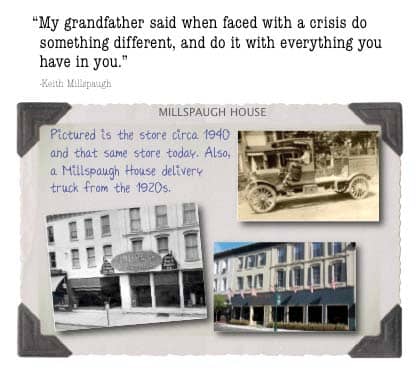
Millspaugh’s story began in Walden, New York, when 17-year-old Theron was introduced to the intricate work of fashioning rough wood into beautiful pieces of furniture and well made coffins. Born to Gilbert S. Millspaugh and Sallie J. Clineman on their farm in Montgomery, Theron was no stranger to hard work. His employer, John Woolsey, was impressed with him, and when John passed to his reward, Theron bought the business from John’s widow. In 1866, he erected a three-story brick building, still the main store today, to replace the original 18’ x 24’ shop. Business grew and additions were built in 1882 and 1890. A dumbwaiter installed in 1895 to take caskets and furniture to the second and third floors is still in use today. In 1901, a doorway was cut to join the storefronts of Millspaugh House and the prosperous general merchandise business of Marcus King Hill next door, creating the largest store in the county.
Said Keith, “We continued steady growth, purchasing the neighbouring 50 Main Street and, before bursting at the seams in the mid-1900s, we built a 2,000 square foot addition over the Hill building. We opened a second store in 1998, leasing 9,000 square feet, the second floor of an historic hill barn outside of Poughkeepsie. Then, in December 2005, we left the barn and moved into a 27,000 square foot space in Hudson Plaza on Route 9 in Poughkeepsie, more than doubling our showroom size. And, in February this year we opened our third store in Warwick. New York.
“I’d been running the business for 27 years, and did business as it had been done in the past. But I realized we were not generating healthy enough profits to sustain us. I turned the focus to business health instead of business survival. At that time we had been operating with an accounting based product and we decided to switch to a furniture industry based program. We chose Profit Systems and we’ve improved our business health with focus on many details that I’d been overlooking.
“In the early ‘20s, we were struggling. My grandfather told the story about he and his brother being asked to leave their careers and come back to the business. The two of them turned things around, going door to door with household appliances which were then just starting to become available.
“My grandfather said when faced with a crisis do something different, and do it with everything you have in you.”
Faller’s Furniture - 1847
In 1847, Evan Faller’s ancestor, Jacob, started the family business in Fryburg, Pennsylvania. He began, Evan said, “by building wagons, coffins and furniture. The original store was destroyed by tornado in 1890, and the second building destroyed by fire in 1908. We rebuilt after the fire and that building stands today in 2010.
“Faller’s Furniture was located in Fryburg until the year 2000 when, to secure market share, we moved the operation to historic downtown Clarion.
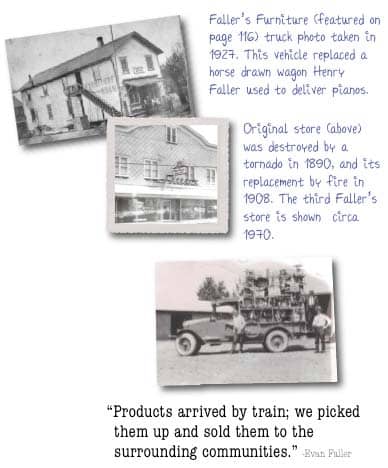
“Our lineage: Jacob Faller, Henry Faller, Bernard Faller, Greg Faller and me, Evan Faller. A few historical facts: my great, great grandfather Henry started selling pianos in the early 1900s. He would load up a wagon full of pianos and not return until he sold them all. He spent many nights around the family table with people from the surrounding countryside, eating as a guest, entertaining as a friend, and selling pianos as a business.
“This continued into the 1920s until the wagon was put aside for better transportation. In the ‘30s, ‘40s and ‘50s, the store sold almost everything for the home. The second floor of the store was turned into a bustling ‘toy land’ during the fall for the holidays every year.
“This was a generation that had limited transportation and roads were not in a condition to really make travel practical. Products arrived by train; we picked them up and sold them to the surrounding communities.
“The most recent innovation was after my father moved the business to Clarion. The original location was not completely used so, in 2003, it was decided to invite a few people to bring antiques to the space and sell them on weekends. It’s since grown from a handful of vendors on the main floor to three full floors of antiques. When walking through the building it’s amazing to see many items that were surely sold at Faller’s decades past!
“We believe our customers want good pricing everyday, and that’s what we give them. If we didn’t go the extra mile, we wouldn’t still be in business after all these years. That is the reason we can say, ‘Serving you for five generations’!”
Greg Faller retired in January, 2010, and Evan, named manager in 2009, has taken the reins of the business. Said Greg, “I’m proud to be handing the business over to the next generation. We’ve been family owned and operated for 163 years and it’s great to know that our service to the community will continue.”
Faller’s is updating its look with fresh design concepts and several new lines of furniture including Canadian Décor-Rest upholstery and leather, and Laura Ashley bedding. They’ve also added Surya and Feizy area rugs, and, recognizing changing demographics, a new selection of lift chairs for the aging population.
L. Fish Furniture - 1858
Travelling due west, our saga continues in the City of Chicago, where L. Fish Furniture’s distinguished history began in 1858, shortly before the Civil War. The founder, David, had honoured his wife Lotta, by using her initial when he named the new company.
“We were doing business when Abraham Lincoln was president and before the light bulb was invented. We even made it through two World Wars and the Great Depression.”
Five generations survived a number of challenges in 152 years of business. They lost their Windy City stores in the Great Chicago Fire and, while they rebuilt them, they moved the company into facilities in nearby Wisconsin so they could continue growing. The Great Depression and the Energy Crisis in the 1970s were also difficult but they survived because they didn’t waver from their solid business plan. They kept a close eye on overhead costs and stuck to their focused plan during tough times. And it helped that they hired some very smart people over the years.
Since the early 1900s, L Fish Furniture and Mattress has enjoyed a presence in Indiana. They opened in Indianapolis in 1952, and the East Washington Street Mega Store 20 years later. The industry’s Golden Rules apply: “We’ve built a strong reputation of offering our customers’ high quality brand name furniture at the lowest possible price. We do whatever it takes to satisfy our customers needs before, during and after the sale.”
Kingsmill’s -1865
North of the 49th parallel, things were moving in London, Ontario. In 1865, Thomas Frazer Kingsmill, an Irish immigrant gifted with foresight, opened his doors on the main street. The present building, the third to house the store on this site, dates to the 1930s when fire destroyed the previous structure. An imaginative step back in time, the art deco style building features original tinplated ceilings, hardwood floors, a pneumatic tube system used to send paperwork and change throughout the store and an old style elevator complete with operator. (A visit to the store is offered amongst the City of London’s scenic tours!)
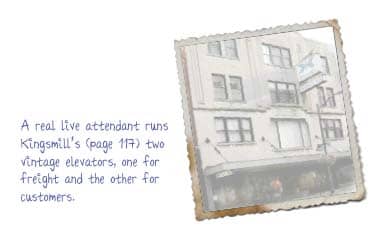
Today, Kingsmill’s continues to be owned and operated by descendents of the founder, one of the few remaining independent department stores in Canada. Fourth and fifth generation family members, both named T. F. Kingsmill after the founder, are active in the business.
Fifth generation Tim said, “In January 2001, a fire in an adjoining business caused extensive smoke damage. Over l8,000 square feet of displayed furniture and warehoused products were removed from the store. It was completely restored, new product purchased and we reopened fully stocked mid-March of the same year. This was the third time in the history of the store that fire disrupted operations.” A retail Phoenix, rising from the ashes!
“Over the 144 years we’ve been in business, we and the store have continually evolved to keep up with ever changing consumer demands and the latest trends in retail. Over the last 10 years, innovations include the opening of a Gourmet Kitchen Shop and the launch of a website that offers online shopping and gift and wedding registries. In March we opened a newly renovated space for a Home Store, offering contemporary urban furniture and accessories targeted at the growing population of London downtown dwellers who occupy the new high rise developments.
“There is no one thing responsible for the success of Kingsmill’s business. It’s a combination of quality products, customer service, dedicated employees, loyal customers, community involvement and an unwavering family commitment to the business.”
John Thomson & Son Furniture -1865
An hour or so northeast of London, you’ll find the bustling town of Fergus, Ontario, in 1872 the site of yet another highly successful entrepreneurial venture. This time a Scottish immigrant, John Thomson Senior, found fertile ground for his energy and imagination. A talented carpenter, cabinetmaker and man of business, he understood that the services of a coffin maker and funeral director should be part of his commercial package, along with developing his own lumberyard, pump factory, headstone shop and insurance company. At his furniture store he carried “a splendid stock of wallpaper in the latest designs, as well as an excellent supply of pictures and picture framing”.
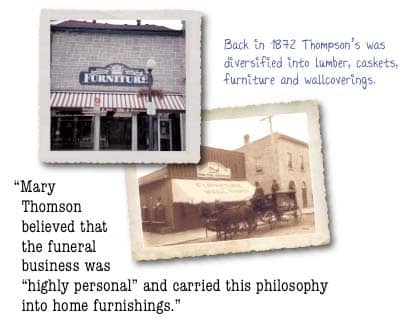
Their first location on St. David Street combined both furniture emporium and funeral parlor. Later, John moved the furniture division around the corner to St. Andrews Street.
In time, John Thomson Junior inherited the business, then William Thomson, his brother and, in 1954, it was Mary Thomson’s turn. A determined, hardworking individualist, she understood the furniture trade but took training to qualify as a funeral director. She believed that the funeral business was “highly personal” and carried this philosophy into home furnishings.
Her nephew and present owner, Neil Johnston, tells this story: “There was a fire at McHardy’s Hardware Store next door which burnt to the ground in the early 1960s. It almost destroyed the furniture store as well. Undaunted, Mary organized a fire sale. Customers lined the streets, and they sold the entire inventory right down to the last lonely bed frame in the middle of the floor. It actually turned out to be great for the business! Mary closed the store after the sale and did a complete renovation, then went on a buying spree and restocked with a fresh up-to-date inventory. Mary always had a way of turning misfortune into opportunity!”
It was when the redoubtable Mary became ill that Neil Johnston, at her request, returned to Fergus from western Canada where he’d been “building trains and streetcars for Bombardier”.
Today, Neil believes that “staying focused on what has really worked well in the past is very important, while constantly adapting to change for the future and also readjusting where needed during market downturns. There are advantages a smaller retailer can draw upon during tough times, not only to survive but in many aspects, thrive. Most important is recognizing that what has worked in ‘good times’ requires a shift in mindset during tough economic times. Inevitable cutbacks in purchasing and advertising require focusing on areas that cost little but have great impact on the continued success of our business. It is more important than ever to focus on customer service and exceed customer expectations. Retaining customer loyalty and referrals are more important than ever in a slower economic environment.
“It’s also a time when I rely on the effectiveness of my staff to keep me informed of customers’ needs and concerns. If one customer has a bad experience, that customer will tell dozens more about it. Turning a negative into a positive is a sure way to maintain customer loyalty and that oh so important ever growing customer referral base.
“Lastly and most important in keeping a competitive edge is of course a terrific staff. I have always been very fortunate in that area!
“The key to our success is to keep learning how to do it better while always maintaining the integrity the business was founded on.”
And there’s one other small maxim. Said Neil, grinning as he observed the ongoing renovation of yet another area of his heritage buildings for showroom space, “We make it a point to expand every 100 years or so!”
As the decades passed, patterns were emerging in the industry. Commitment, perseverance, integrity, humour... and good common sense.
Hoitt’s Furniture -1880
Manchester, New Hampshire, was one of the largest textile centres in the world in 1880. Charles A. Hoitt saw opportunity and jumped in feet first. The textile enterprises demanded a complex railway service, and a quick-thinking and clever entrepreneur in the quality home furnishings business was able to ship sold merchandise to literally any locale. Hoitt’s Furniture rapidly became synonymous with “better end” furniture, and their ability to service what they’d sold. His perceptiveness was transmitted to Carl Longo when he acquired the company, and continues today under the direction of Carl’s son, Brian.
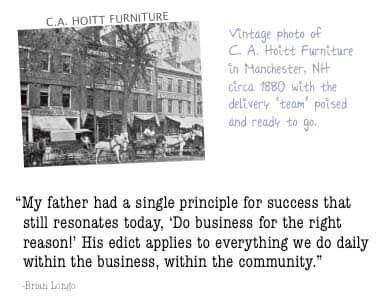
Said Carl, “A lot of history has transpired since 1880, Wars, Depressions, Recessions, not to mention enormous social and economic change. But in the face of all that, we’ve remained steadfast in the mission, set by Mr. Hoitt and continued by my father to provide fine quality furniture to our very loyal customer base. Partnerships with vendors have lasted for generations.”
And, said Brian, “The success of any business is based on a multiple of variables. Volumes have been written, degrees have been awarded and scores of stores have come and gone as evidenced lately. My father had a single principle for success that still resonates today, ‘Do business for the right reason!’ His edict applies to everything we do daily within the business, within the community and encompasses 130 years of tradition and success. Thanks, Dad!” Hoitt’s mantra, “For the quality you want, trust the name you know!”
W.S. Broom -1885
Five years after Mr. Hoitt made his mark, two brothers opened the J.E. Broom Outfitting Company in downtown Effingham, Illinois. John and Warren offered a comprehensive line of furniture, and almost anything else you might have on your lifestyle list, circa 1885. Sewing machines, baby carriages, hammocks, croquet sets and carpet sweepers were available. If they didn’t have your item of preference on hand, you were encouraged to ask for it.
Eight years later, Warren and a silent partner bought John’s share of the business for the princely sum of $5,000, and renamed the store W. S. Broom & Company. But that same year, recession hit the area and to stay in business they began manufacturing mattresses from cotton, felt, kapok and down. The sideline proved so profitable they produced mattresses until 1914, at the outset of World War I.
Warren bought out his partner in 1928 for $6,000 and became sole proprietor. That same year, William L. Broom Sr., Warren’s son, became the store manager at a salary of $25 a week. Bill’s wife, Winifred, was store bookkeeper and their sons, William Broom Jr. and James David literally grew up in the family business.
Because Effingham was located along the Illinois Central, Vandalia and Wabash Railroad lines, the enterprising Brooms promoted a successful mail order business until World War II, when they served as agent of the U.S. Army, packing and shipping goods to various army bases.
Bill Jr. after serving in World War II and graduating from the university of Illinois, in 1949 began working in the family store and Jim joined the business in 1956. Two years later, on the sudden death of her husband, Winifred became owner of W.S. Broom & Company. Winifred walked to and from work every day and kept track of store finances until she retired early at age 82!
Family involvement continued when one year before Bill Jr.’s retirement in 1989, his
daughter Nancy joined the store. She is now Customer Service Manager. Five years later, Jim’s daughter Jamie and her husband Jim were added to the corporate family, currently as Buyer/Marketing Manager and Flooring/Warehouse Manager.
Meanwhile, over the years, Broom quietly expanded to its current size of 40,000 square feet, still located close to its original site. And in 1972, a flooring store/furniture warehouse was added at the site of the Broom’s family home, only six blocks from the main store.
Staff loyalty and longevity of service still resonates in retail success profiles. Only one employee has worked for the company for less than 10 years and three of them have been over 25 years with the company.
W. S. Broom philosophy resonates to the needs of small town living. “Listening and responding to customers is a priority and a necessity!”
Havertys -1885
It was also in 1885, that a gentleman by the name of J. J. Haverty decided the time was right to establish his furniture company in downtown Atlanta, Georgia, a city that still bore the marks of the huge upheaval of the Civil War. Southerners were beginning to put austerity behind them, and Haverty was in the right place at the right time. “Sales collectors” made their rounds in smart horse and buggy style, as Havertys moved into Missouri, Tennessee, Arkansas and beyond.
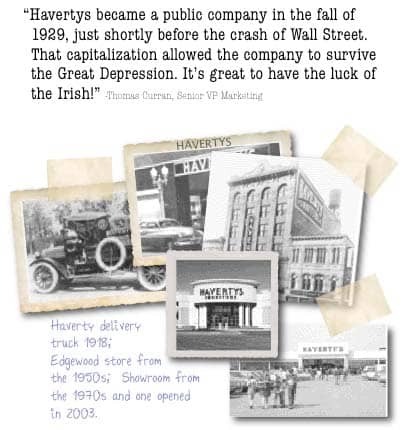
Now there are 122 full service Haverty home furnishings retail stores in the middle to upper middle price ranges. They serve 80 cities in 17 states in the Southern and Midwestern regions. And their quality products are also sold through catalogues and their comprehensive website.
Good corporate citizens, Havertys lends financial and moral support to many national and community organizations, amongst them the American Heart Association, the American Red Cross, Habitat for Humanity, the Salvation Army, the United Way, The Susan G. Komer Breast Cancer Foundation and Goodwill.
Said Thomas Curran, Senior Vice President Marketing, recently, “Most interesting from a historical point of view is that Havertys became a public company in the fall of 1929, just shortly before the crash of Wall Street. That capitalization allowed the company to survive the Great Depression. It’s great to have the luck of he Irish!”
Tim Kingsmill would probably agree. So we’ll add “luck” to our rolling roster, even if you’re not Irish!
Darsey’s -1873
The state of Texas was the kick-off point of the epic adventures of the Darsey family when George E. Darsey Senior left Georgia in the fall of 1873 with his aunt, Mrs. Harriet Cash. He worked on the Shivers farm on the Trinity River and when his aunt returned to Georgia, he moved to the town of Crockett where he clerked in a general store. He also carried the mail on horseback from Crockett to Centerville, and worked as a traveling salesman for a time.
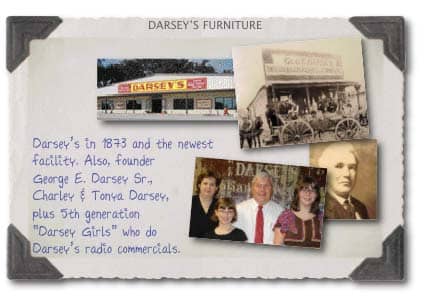
Right from the get-go, George had the habit, indeed the rule, that he saved a part of his earnings regardless of the amount he was making. This enabled him to accumulate the capital he needed to go into business in Grapeland with John R. Foster. According to Mr. Foster, “George had $465 and I had $765. We had a pretty hard time getting started off, but we soon began to make money”.
George bought out Mr. Foster’s share in 1886, just one year after Messrs. Broom and Haverty bit their respective retail bullets, and he continued the business under his own name.
The original store was a frame building that housed a wide variety of merchandise, furniture, of course, dry goods, groceries and all types of farm equipment. Twelve years later, as the business grew, he replaced the frame structure with Grapeland’s first brick building, 27’ x 125’.
In 1900, George persuaded his cousin, William G. Darsey, to move to Texas to help him. A skilled bookkeeper, William set up a double entry system of books; the same system is in use to this day. He slept in the store at night and, in turn of the century Texas, his rest was often punctuated by town rowdies rampaging up and down shooting out the streetlights.
In 1907, another brick building was added, and the cousins departmentalized their inventory. By 1913, the Darseys had six buildings, all of which were destroyed in a disastrous town fire. However, some of the merchandise was saved and they were in business again the next morning on the railroad siding in rented box cars. Resourceful, immediately after the fire, they erected a corrugated iron warehouse on the block directly behind the burned out stores, and this structure housed the business until the new store was ready for occupancy.
A more complex structure, there was provision for an office with a brick vault which effectively kept records and deeds safe in case of fire, and a large safe for money. Many customers used Darseys as a depository for their valuables and as an “early day” bank. Farmers borrowed money by the year to make their crop, and pay in the fall when the crop was gathered. In 1907, George E. Darsey Senior was one of the organizers of the first bank in Grapeland, the Farmers and Merchants State Bank.
In 1917, the store evolved from a proprietorship to a family partnership which expanded to include more family members after George E. Darsey Senior’s death. In 1953, George E. Darsey Junior and his son, Charley C. Darsey, bought them out. With the death of George E. Darsey, Charley now owns and operates the business.
Darsey’s was run as a country store, a family type business, and helped train not only the Darsey children but many other young people especially during the Depression years. When sons of the owners and the employees graduated from university in the 1930s and jobs were short, they drove cotton trucks to Galveston.
Will Darsey joked, “only boys with college degrees could drive trucks for Darseys!”
Once the daily business of Darsey’s Store included “everything from selling mules to buying cotton, from selling whiskey by the barrel to yarn for knitting.” In the Augusta news section of the Grapeland Messenger of 1907, the local reporter wrote, “if you cannot find what you need in the Augusta stores, then you should go to Grapeland because George Darsey sells everything from toothpicks to ocean liners”
In October of last year, a tornado destroyed the old warehouse building and Charley “moved forward” once again and “built a new million dollar facility with 40,000 square feet under roof. The 15,000 square foot old store is now used for storage, and there’s another 25,000 square feet of new showroom space.
“The business practice that has benefited our success is same day delivery; that stands out in front. And our slogan, ‘Buy it today! Get it tonight!’ A practice that benefits our community is sponsoring the local Relay for Life and other charity events. We always try to remember there are others less fortunate than us.”
But going back 124 years, Darsey’s Law stands tall; “During the good times, always remember to save for the hard times”. It’s a keeper.
Montgomery’s Furniture -1888
Montgomery’s Furniture, one of the oldest enterprises in the State of South Dakota, has been open to the public “in the same town, the same business, owned by the same family for over 122 years”. It was founded by George Montgomery in Dakota Territory in 1888 before South Dakota had become a state. The fourth generation of the family is active today with Jim Loomer and his son Todd owning stores in Mitchell and Alexandria. Their longevity is attributed to “unbeatable service, outstanding selection of quality merchandise, and great values” and perhaps most telling, the loyalty of generations of the same families returning to Montgomery’s to buy their home furnishings. “Long term customer relationships” are key. Plus, Montgomery’s are members of A.M.I. Furniture Leaders, thus adding to their buying clout.
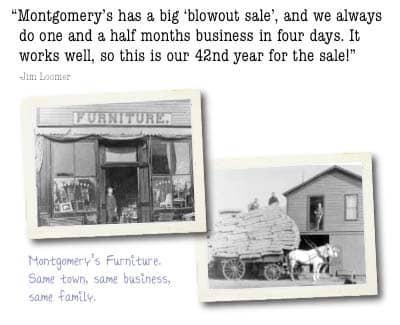
“Every March we have our big ‘blowout sale’,” said Jim, “and we always do one and a half months business in four days. It works well, so this is our 42nd year for the sale!”
Jim still keeps regular 48-hour weeks at the store after 55 years, and Todd can now count 22 years to his credit.
The Loomer’s message? “Communicate with your customers; build long term relationships, build loyalty and trust.”
Klingman’s -1896
It was getting close to the turn of the century. In 1896, Grand Rapids was becoming famous as the Furniture Capital of the World. The Klingman family saw opportunity as the whole of downtown Grand Rapids was being developed into buildings for showrooms. Present owner Bob Israel said, “At the top of Klingman’s game, it had a 600,000 square foot building. There were 300,000 square feet of showrooms on five floors, and warehousing as well.”
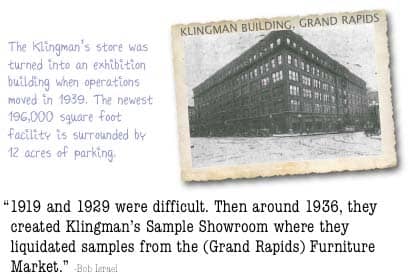
Like many retail operations, Klingman’s history fluctuated with the rise and fall of economic times. “It seemed to run in ‘nines’”, Bob told us. “1919 and 1929 were difficult. Then around 1936, they created Klingman’s Sample Showroom where they liquidated samples from the Furniture Market. 1939 was most trying. Many of the factories in Grand Rapids were manufacturing airplane and PT boat parts. The era of no furniture purchases caused Klingman’s to go into a receivership situation.
“It was during this period that the Klingman family sold their interest to Chris Vandenberg and his two sons, Jay and Bill who brought the Sample Showroom to a new building. Well trained in the furniture business, they developed a network of customers including all GM and Ford employees with specialized discounts. During the ‘50s and ‘60s, they developed Klingman’s into a very strong organization, although it was during this time that the exodus occurred from downtown to malls.
“In the early ‘70s, they sold Klingman’s to the Joshua Door Company. When the owner, Harold Victor, passed away in the early 2000s, Harold’s son Jonathon ran the business for a couple of years. And then Designs for Living bought Klingman’s.
“Israels Company, a Designs For Living Corporation, was started in 1977 as a retail company for furniture. At the time of purchase, Klingman’s was moved to a 390,000 square foot showroom, and a new warehousing operation of 290,000 square feet racked.
“Now known as ‘Klingman’s, A Designs For Living Company’, the business itself is 38 per cent ahead of projected sales. The overall plan is to grow it by five and one-quarter per cent every year and to consistently take on more market share.
“We have consistently built on the old customers; it isn’t something we take lightly. We try to take care of each customer personally. We offer special things for each customer individually, whether it be rewards or product to use until their ordered product comes in. The most challenging thing, particularly with better quality furniture, is to continue to move forward, taking care of our customers and communicating with them.
“The success of our business really relates back to the company policy that I wrote for all of our companies, the mission statement, on my belief in God, the wisdom of the Bible and the free enterprise of the United States.”
Wolf’s Furniture -1902
In 1902, the Victorian era was fading into history when Charles Wolf and his partner, John Fox opened City Furniture Company in downtown Altoona, Pennsylvania. In 1915, Charles bought out Fox’s interest and started construction on a five-story building, “the largest furniture store between Pittsburgh and the state capitol, Harrisburg.”
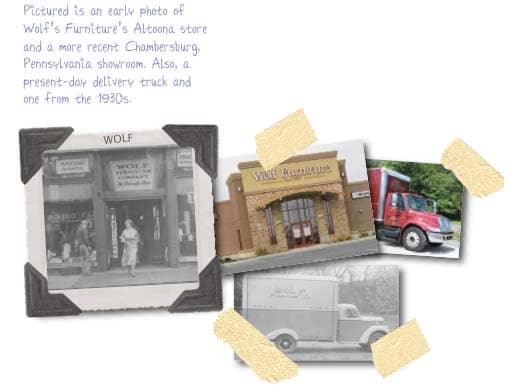
Charles’ dream store was completed in the spring of 1918. A few months later, a major influenza outbreak hit the U.S., and Charles, at age 54, left a widow with five children and a big mortgage.
Fortunately, Annie had a good head for business and mentored two of their sons, skilled in merchandising and promotion, finance and operational controls. They formed a successful partnership and prospered for 55 years.
Legend has it that when customers were not able to make their account payment because of job layoffs during the Depression, Annie would ask them if they had a garden. Customers would then be invited to bring in their tomatoes, corn, eggs, etc., which she would sell to their employees and apply those monies to the delinquent accounts.
And, of course, when the job market turned around, grateful customers returned to buy their furniture at Wolf’s. They confirmed a longstanding truism; “Word of mouth advertising is invaluable!” During the Depression years, Wolf’s opened one new store each year.
Said John Wolf, third generation Chairman, “As the transition of management from the second to the third generation came about during the 1960s, the communities that sustained Wolf’s growth for so many years were going through major declines in their employment base when jobs in key sectors like coal, rail, steel and related manufacturing experienced substantial deterioration. As management struggled to implement new concepts in fashion merchandising, new locations and updated advertising, it gradually became clear that a major restructuring would be needed to deal with the changing customer demographics.
“In 1922, a decision was made to redeem the majority of outstanding shares through a sale of 14 of the corporation’s 17 stores that covered a wide geographic area in three states. The results of this sale to a major NYSE company, left Wolf’s with just three stores and a substantial infrastructure run by a very basic crew.
“Implementing the new strategy called for major changes in marketing, merchandising and financial operation, but over a period of many years the company has grown back to a base of stores that now places them among the top 75 companies in our industry.
“Through four generations, the family at Wolf’s has always adhered to the basic philosophy of our founders; do business by the Golden Rule. Treating others as you would wish to be treated has resulted in exceptional goodwill for all involved; customers, associates, vendors, suppliers, all are treated with proper respect and fair dealing.
“In my 50 years of association with this business, I have been fortunate to work with and learn from an exceptional group of men and women who are devoted to advance the interests of this industry.
“N.H.F.A. has been an ongoing source of professional advice and idea sharing. Jerry Wolf, a cousin who served as President of Wolf’s during the 1970s, was very active in N.H.F.A., serving as President and Chairman in 1981 and 1982.
“Doug Wolf, fourth generation and current President of Wolf’s, continues the tradition of active service to the Association, as a long-term member of the Board’s Executive Committee, spearheading the Vendor Relations Group. This sharing of ideas as promoted by N.H.F.A. and other industry services has benefited all involved.
“Thanks also to Furniture World and other industry leaders whose service ethic makes all participants better for this exposure to progressive ideas.
“Wolf’s has worked hard to attain their 100 year plus record of service to our customers, employees and our industry. May it continue to honour the legacy of past generations.”
Guynn’s -1902
Harold L. Williams has the good fortune to live and work in one of the most beautiful regions of Virginia. Vice President of Operations for Guynn Enterprises since 1968, Harold related Guynn’s fascinating story. “It was in 1902 that J. Crockett Guynn left his teaching position to establish his first country store located about four miles west of Hillsville, Virginia. He stocked it with general merchandise from the smallest sewing needle to the largest piece of farm equipment. Customers traded butter, eggs, apples and chickens for family needs including clothing and furniture.
“In winter, Mr. Guynn bought rabbits and droves of turkeys from his customers. He employed neighbours to pluck and dress them, and load them onto a mule drawn wagon sent to Galax to ship by train to large city markets. The wagon, on return, was stocked with merchandise for the country store. According to a depot clerk at the time, ‘Crockett Guynn receives more merchandise than any other merchant in the Galax area’.
“Crockett Guynn moved his store into a larger and more modern building in 1912, a two story storehouse with plate glass frontage and a second story to be used to house coffins and caskets which he began stocking in 1913.
“In 1919, Mr. Guynn purchased a horse drawn hearse and, in 1923, in order to update his funeral business, he sent his oldest son, Gilman, to school to be trained as a licensed embalmer and funeral director. This would bring on a more dignified funeral service.
“Crockett concluded in 1927 that business trends called for a move from the country to town. He started a hardware and furniture business in a large two-story structure on the corner of the Main Street and Jail Alley in Hillsville. He left his country store to be run by his wife, Lura. He rode horseback every day from his home to town. In 1928, the Guynn’s purchased the county’s first motor hearse as better roads made its use practical. In 1931, they bought the area’s first combination ambulance hearse. This initiated an ambulance service for Carroll County residents.
“Disaster struck in 1932 when fire destroyed a large portion of the business section of Hillsville, and left the store completely burned. Even though it was during the Great Depression, Crockett built a new two story brick building on the same site.
“In 1936, the funeral business was separated from the hardware and furniture business. Modern funeral homes were established in Hillsville and Galax.
“J. Crockett Guynn died in 1936, and his son, Gilman, continued to run Guynn’s with the same policies of fairness and service to the community.
“Gilman added a new wing to the building in 1943 exclusively devoted to furniture as it was becoming a much more important part of the business.
“In 1945,” Harold Continued, “Gilman’s younger brothers Carlin and Garnet returned from service in World War II and joined him in the family business. Carlin ran the Hillsville store, and Garnett ran a wholesale grocery, feed and farm equipment business in Galax until 1973. After World War II, Gilman’s son, Jack E. Guynn, finished college at Virginia Polytechnic Institute and took over the funeral business in 1949.
“On February lst, 1950, Dale Ward, another veteran of World War II, came to work with Garnett at the wholesale. He transferred to the Hillsville store in 1973, and still works full time. He completed 60 years on February 1st, 2010. And on March lst, 1968, I joined as Vice President of Operations and still serve in that capacity.
“Guynn’s opened a store in Independence, Virginia in 1947 and one in Pulaski, in 1959. Near the end of 1968, Guynn’s opened a 20,000 square foot store in Wytheville and built a 28,000 square foot store between Blacksburg and Christiansburg. During 1969, Guynn’s built a new 45,000 square foot building with more than one acre of parking in Hillsville. In 1970, they built a shopping centre in Independence. In addition to the 20,000 square foot furniture store, more than 20 businesses are located in the centre. In 1972, a new 40,000 square foot building was built in Pulaski. The Roanoke and Pulaski stores were combined in this building.
“Gilman Guynn died in September, 1973, and Jack Guynn became President of all Guynn Enterprises. Jack had been very instrumental in all phases and expansion of the business. Mary. R. Guynn, his wife, became Secretary-Treasurer.
“Also in 1973, the wholesale business in Galax was closed and a furniture store was opened in the building.
“On March 19, 1979, Jack E. Guynn died, and Jack E. Guynn, Junior, ‘Jay’, became President of the various enterprises.
“In 1984, the decision was made to lease all stores to other furniture retailers except Hillsville, Galax, Independence and Wytheville. Guynns wished to better serve the local area than to further expand.
“Stephen M. ‘Steve’ Williams, with more than 25 years service with Guynns, is General Manager of Guynn Furniture.
“Thus the Guynn tradition has passed on from father to sons, to grandsons and great grandsons, always trying to keep the same principles of satisfaction and services guaranteed by J. Crockett Guynn in 1902 and also operating on the philosophy explained by Crockett Guynn. ‘If I want to make sales, I must be sure to have what the customer wants’.”
Schleider Furniture -1902
It would seem that 1902 was a very good year. In Brenham, Texas, Herman Schleider, his brothers and children, opened their first operation, a cotton warehouse, dry goods store and saloon. The railroad was vital to Brenham’s business in the decade that followed, and in 1915 the Schleiders broke ground on a new store in its present location across the street from the railroad depot. It was ideally situated to both receive merchandise and to attract weary rail travelers to its saloon.
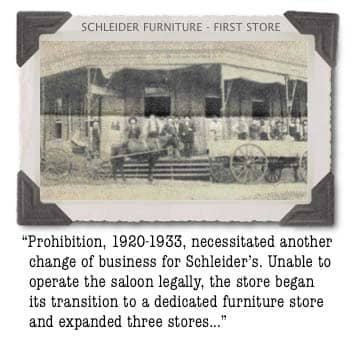
But the venture was not without complications. Originally designed as a two-story building, the foundation crew discovered quicksand in the store’s footprint. To stabilize the site they created a third floor, a basement sitting atop a 16-inch deep cement mat crisscrossed with 120,000 pounds of reinforced steel. To this day the building is solid. Its neon sign, which still burns brightly every night and on cloudy days, was Brenham’s first.
Prohibition, 1920-1933, necessitated another change of business for Schleider’s. Unable to operate the saloon legally, the store began its transition to a dedicated furniture store and expanded three stores to the towns of Taylor, San Marcos and Bellville under the leadership of Herman’s son, “Mr. Ben” Schleider. Named 1961 Furniture Retailer of the Year, Schleider’s operated one of the industry’s first retail computer software systems.
In 1975, the Schleiders sold the store to Herbert Maddock, a recently retired executive of Joske’s of Houston. His wife, Marjorie Maddock, also honoured as Furniture Retailer of the Year in 1983, was a modern retailer who proudly continued the store’s tradition of excellence and innovation.
As Schleider’s began its second century of business, control passed to Maddock’s son, John. He and his wife, Kate, share the store’s executive office where, at an antique partners’ desk from the Union Pacific railroad depot, they design and create most of the store’s advertising and marketing in-house.
Today’s Schleider Furniture features a 32,000 square foot showroom on three floors, and a La-Z-Boy Comfort Studio opened in 2008. Its fully integrated retail software system is, in Mr. Ben’s style, cutting edge.
Kate Alexander Maddock, Schleider’s Vice President, quoted Herb Maddock, who wrote: “The dictionary defines tradition as the handing down of statements, beliefs, legends and customs especially by word of mouth or practice. Schleider Furniture illustrates that definition. These days, the idea of roots and continuance are much in the minds of people. It is good to dwell on a measured piece of time and unchanging standards and practices. As Ben Schleider wisely said, ‘We have a code to treat our customers in such a manner that we never need to say, “I’m sorry.”’
1905 -Kirkpatrick & Witt Furniture
Three years later, Kirkpatrick and Witt Furniture made their mark on the Texas scene. Sam Kirkpatrick had opened Waco’s first furniture store in 1900, and in 1905 G. C. Witt and Connie Jones established Witt & Jones, Waco’s second. They survived the Great Depression and the Waco tornado, even though the tornado destroyed both buildings and all their merchandise. They rebuilt in the old Waco Square. In the 1960s, urban renewal required the demolition of those buildings. It was later in the ‘60s that R. A. Witt, then owner of G. C. Witt & Sons Furniture, purchased Kirkpatrick’s store and combined the two names and consolidated the companies along with their by then huge customer bases.
In 1986, Cleveland Witt and Robert Goldsmith as partners purchased the corporation. In 2000, Mike Goldsmith, Troy Goldsmith and Lee Bauman became partners in Kirkpatrick and Witt.
In the early 1970s, Connie Whit became one of Waco’s most recognizable faces and voices of television and radio as the sales force behind Kirkpatrick and Witt. Today, after 30 years, she’s still going strong!
Cleveland Witt told of the partners’ intent to “carry our own paper after surviving the Depression. To accomplish that goal we determined to inventory a full line of furniture and appliances, leaving no excuse for our customers to shop elsewhere. Next, we became ‘family’ to our customers, offering in-house maintenance of both furniture and appliances. We had our own upholstery operation on the third floor of our five-store chain.
“Then we created a policy to cash all customer checks and we built a huge following by doing without charging. This service hit a high in 1980 when it amounted to several million dollars convenience for the benefit of customers.
“We purchased our present location and consolidated our chain stores in1969. This has paid off in more profit and value appreciation.
“Another major step was to hire our own internal maintenance personnel and contract most major brands doing business by serving other businesses as well.
“We believe in advertising, and have been cable TV’s greatest advertiser! We follow the $10 payoff on every dollar spent.
“We continue to add to our lines and have expanded into jewelery and dishware.
“Our sales in appliances and electronics are each 12 per cent. It’s a great convenience to our furniture customers to only carry one account. It also builds our maintenance aspect.
“We believe service to customers is our strength, thus we carry a large warehouse and delivery crew, a great selling point, as we do not charge. We are the only major store with free delivery.
“Early in the 1980s we enacted a vigorous advertising campaign to capture the Spanish trade. Very successful, it resulted in a 30 per cent increase in customers!”
“The success of Kirkpatrick and Witt Furniture is defined by the fact that we control our own business. We do not let the competition define us; we do not let the manufacturers dictate to us, and we do not let the customers run our business!”
1906 - Goldstein's
It was in 1906 that Myer Nathan Goldstein established his first venture in Sharon, Pennsylvania. Said today’s President/CEO Steven M. Goldstone, “After more than 100 years in business, why do more than 50,000 customers continue to shop at Goldstein’s every year?” The “Ultimate Goldsteins Guarantee” could have something to do with it. Goldstein guarantees price, quality and service and has done so every year of its long life.
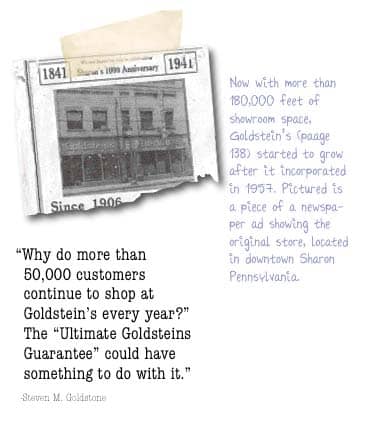
Perhaps even more powerful is the strength of the generations, each taking its turn in the development and nurturing of the founder’s concept.
Myer died in 1921 and his children, Louis and Sadye, along with Sadye’s husband, Rudolph Goldstone, operated the business. When Louis died in 1939, the Goldstones assumed management. In turn, their two sons, Arthur and Myron took their turn.
The company was incorporated in 1957, and it began to grow. In the next three decades, Goldsteins of Ohio Inc. opened a store in Eastwood Mail, Niles, Ohio, another in Boardman, Ohio, later to be relocated in Canfield. In 1991, a 4,900 square foot addition was constructed to the showroom in Canfield and in 1993, more construction, a 3,600 square foot addition to the Canfield store for stockroom use. In the meantime, warehouse space was increased in Sharon.
Arthur Goldstone became the sole owner of all three Goldstein companies in 1995 and two years later, they merged into M. N. Goldstein Company. There were more additions in 1998 and ’99. In February of ’99, Art’s son, Steven accepted the role of President/CEO.
The millennium saw more expansion, and the creation of a new corporation, GoldAsh Furniture with an additional store, Ashley Furniture Homestore.
Now trading in a five county area, Goldstein’s market demographic is 25-54 and, in a recent study, Goldsteins was shown to be the leader when people were asked about “the first furniture store that comes to mind”. With more than 180,000 square feet of showroom space, Steve advertises extensively, 46 per cent in network television and 28 per cent in direct mail, some radio, some newspaper.
Steve Goldstone “has no choice but to keep the company growing”; it was his father’s dying wish. And there is, perhaps, yet another Goldstein’s on the horizon.
1908 - Rupp Furniture & Carpet Company
In 1908, Henry Ford introduced the Model T, a landmark in automotive history! That same year, in Archbold, Ohio, the formal opening of Rowe & Rupp Company was announced. It was November 28th, just in time to cash in on holiday purchases. The partners created a postcard invitation directed to potential customers. It informed them that as a reward for attending the opening, “a fine souvenir will be given to one member of each family represented”. Also, “Every person who visits our store will be given a ticket on a fine Mohair Davenport, which will be given away absolutely Free at 3:00 p.m. standard time.” There’s no record of the winner, but one can only believe that she or he became a great, long-term customer!
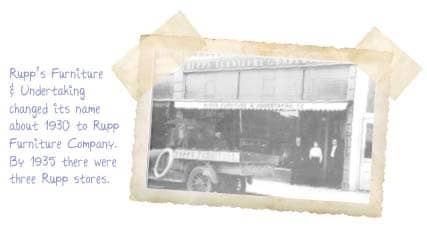
There were four partners back in 1908, Frank Rowe, Lewis Rupp and two brothers, Albert and Edward Rupp. In 1910, Albert, Edward and Peter Rupp, took over the business and changed the name to Rupp Furniture and Undertaking. Peter’s salary at that time was $12.50 a week. All four of them received embalming licenses, and that part of the business continued for 20 years. Caskets were stored on the second floor of their building.
By 1930, they changed the store’s name to Rupp Furniture Company, and they moved to a new location. Ed offered David P. Rupp Senior a job in 1935, just out of high school to perform sales, deliveries and janitorial duties. He also earned his mortician’s license, but never used it. By this time, there were three Rupp stores, located in the towns of Archbold, Wauseon and Ridgeville Corners.
In 1946, Peter’s son, Paul E. Rupp, became a partner with David and Peter. He stayed with them for 10 years, then left to begin his own floor covering business. In 1953, they bought the building in their present location in Archbold. After remodeling, they staged a grand opening in August of that year and, over the next 20 years, there were many changes. Back in 1908, the business sold furniture and area rugs. The list grew to include carpet, accessories, appliances and even televisions. They were the first store in Archbold to sell television sets, and one was displayed in the front window and turned on at night so that people could watch. It had to be turned off, eventually, to avoid the danger of the crowd breaking the glass!
William G. Rupp, just returned from the Navy in 1959, bought his father’s interest in the store. During the ‘60s, a third floor was added to the building, a unique feature in Archbold.
Since then, there have been Rupp stores in many locations. The Bryan store, purchased in 1978 from Huenefeld Furniture, is still in operation. Two new partners arrived in 1972, Dave’s son, Anthony bought one-half of his shares, and Timothy, William Rupp’s nephew, purchased the other half. After 50 years in business, David retired and sold his share to his youngest son, Phillip in 1986. There are still four Rupp family members at the helm, equal partners William, Anthony, Timothy and Phillip. And the name of the business is Rupp Furniture & Carpet Company.
Said Tony, “Take good care of your prospective customers, your current customers and your past good old customers. Be helpful and sympathetic to any problems they have.” He further advised, “Keep a balance of retained earnings available to use as needed in slow economic downturns.” And you need to “Let customers know we are planning on staying in business!” Proof of the pudding, “A woman came in recently to buy carpeting. She commented that her first purchase from Rupp Furniture was 60 years ago from my father, David!”
1909 -Leon’s Furniture
Ablan Leon left Lebanon to seek his fortune early in the nineteen hundreds. A born salesman, he worked his way around a good portion of two hemispheres, South America and the United States. He finally came to rest at Welland in southern Ontario, busy and prosperous because of its position on the heavily trafficked Canal linking Lakes Erie and Ontario.
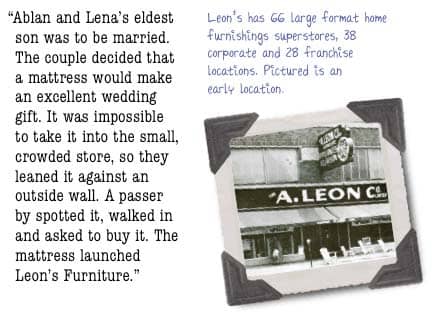
He had saved most of his hard-earned profit from selling clothing door to door to finance the purchase of a small building in Welland’s working class district. In 1909, The A. Leon Company officially opened the doors to its long and profitable history.
Ablan had vision and a kind heart. Immigration was rising and many new Canadians had difficulty obtaining credit. He believed in them and helped them, endearing himself to his loyal customers.
And here is one of the love stories I promised. Once he had a sound business foundation in place, he went back to Lebanon to claim his bride, Lena. Together they built their dynasty of 11 children. As they grew, all worked in the soft goods store, dusting, sweeping and washing display windows.
Decades passed, and Ablan and Lena’s eldest son was to be married. The couple decided that a mattress would make an excellent wedding gift. When it was delivered, they discovered it was impossible to take it into the small, crowded store, so they leaned it against an outside wall. A passer by spotted it, walked in and asked to buy it. Since there was still time to get a replacement mattress, Ablan sold it for a few dollar’s profit but, to his amazement, a much larger profit than could be made on soft goods. The mattress launched Leon’s Furniture. And coincidentally, in the twenty-first century, a mattress was the first item sold online!
When Ablan died in 1942, the operation of his now thriving business became the responsibility of his sons and daughters and, in the ‘50s, Tom Leon and his brothers began expanding to other towns throughout southern Ontario. Tom married in 1949, adding seven more Leons to the family team. Tom now has 19 grandchildren. Leon’s has always been a family affair!
In the early ‘60s, Leons took the biggest risk in their long history and moved to the city of Toronto. The team soon established a strong presence. This increased confidence, and new stores were opened in Ottawa, Kitchener and London.
By the late ‘60s shares were issued on the Toronto Stock Exchange, and Leon’s became a publicly traded company. This allowed anyone to participate in ownership while still enabling the Leon family to control the majority of the shares.
In 1973, Leon’s introduced the first warehouse showroom superstore in Canada. Its success encouraged the company to open new warehouse and showroom superstores.
The Company formulated a plan in the early ‘80s that would enable Leon’s to establish itself in smaller cities by joining forces with independent furniture retailers. There are now numerous franchise stores.
In 1996, the Company initiated another era of major expansion, the first phase including a superstore in Mississauga, Ontario, that featured innovative, award-winning design concepts. That same year, the Company moved into a spacious new corporate Home Office, strikingly designed. And Leon’s continued to open more stores, each improving on the last.
In brief, there are 66 large format home furnishings superstores, 38 corporate and 28 franchise locations. Roughly 20 million consumers visit a Leon’s store each year. Twelve Leon family members, including the fourth generation, are still involved in the business, and there are more than 3,700 associates, extended family members, across Canada.
Leon’s marketing must be mentioned! Their tongue in cheek commercials have won many awards and been featured on “America’s Funniest TV Ads, Leon’s “No Money Miracle” attracting special attention. And 90 per cent of Canadian households receive Leon’s flyers on a monthly basis.
Ablan would be amazed. And very proud.
1910 -Dearden’s
If you live in California or have visited the west coast, there’s no way you could possibly be unaware of Dearden’s! The business was founded in 1910 by Edgar Dearden in downtown Los Angeles, still the headquarters office. It’s the oldest furniture store in the Western United States, now in its fourth generation of family ownership. There are currently nine stores located in Huntington Park, Pico Rivera, El Monte, Santa Ana and Van Nuys, Commerce, Anaheim and Chino, with a distribution centre in Rancho Cucamonga.
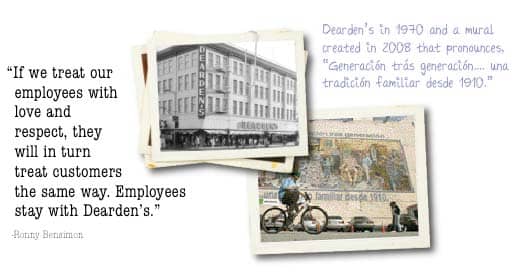
Management recognized the early signs of change in the demographic makeup of Southern California in the late ‘50s when the Hispanic population of Los Angeles was growing at a rapid pace. They sagely began to change their marketing focus and today Dearden’s caters almost exclusively to the Hispanic community. All advertising is done either in Spanish and English, or in Spanish only. All employees in contact with customers are required to speak fluent Spanish.
Ronny Bensimon and his parents moved to the United States from Morocco. His mother, Raquel, was hired at Dearden’s because she could speak Spanish. She had a degree in finance but no knowledge of English, so Raquel’s first job was addressing envelopes in the mail room. Today she is CEO.
In the spring of 1974, 17 year old Ronny was looking for a summer job. His mother, Raquel, suggested he “come down” to join her at Dearden’s. He worked first in the warehouse, then continued to work at Dearden’s through the rest of high school and college. Today Ronny is the President and COO. Two real success stories.
In response to customer needs, Dearden’s provides value-added services which include income tax assistance through H&R Block, full service travel agencies located within the stores, home delivery service in Mexico and Central America and bill payment services.
Said Ronny, “We provide in-house financing for over 90 per cent of the sales we make. A large portion of the Hispanic community doesn’t qualify for credit in a lot of places. We found ways to offer the community credit and have been very successful.
“Similarly, we noticed that a lot of our customers did a lot of travelling home to visit family and we thought it would be a natural for us to offer this service on credit.” Dearden’s uses a variety of methods to qualify customers other than FICO scores.
“Between 75-80 per cent of our sales are customers who have purchased from us before. We treat them well. It is substantially less expensive to bring in repeat customers.”
Ronny says his success is due to his employees. One of the company’s philosophies is, “If we treat our employees with love and respect, they will in turn treat customers the same way. Employees stay with Dearden’s. They know they have the potential to grow”. They are also motivated to become a part of the Millionaires Club, eligible to salespeople that sell over a million dollars in a year. “Last year we had 27 salespeople that qualified. We also recognize employees who demonstrated great customer service with the ‘Extra Mile’ award.”
Dearden’s supports charitable organizations and community activities including providing college scholarships to underprivileged children from local high schools. In place since 1966, this program currently gives students 56 scholarships every year, and a guarantee of employment for the four years they are in college. And the company also hosts a golf tournament annually benefiting “Para los Ninos”, an organization that assists at risk children and their families and has raised more than $1,300,000 for them. And much, much more!
“With this difficult economy, we have looked at our processes in all departments and aspects of our business, and found there were things we could do better and more efficiently. Sometimes it takes a crisis to help you uncover things that you tend to overlook when business is good. And we had to step up our customer service. Even if our customers cannot buy now, they will eventually, and we want them to think of us when that time comes!”
1911 - Grand Home Furnishings
Back across the country in the Blue Ridge Mountains, Virginia was booming with commerce in 1911. The City of Roanoke in the southwestern portion of the state, was experiencing dramatic growth. Grand Home Furnishings began as a piano store in a new building that had been erected at the corner of Kirk Avenue and First Street. Twenty years later, they branched into furniture, radios and phonographs.
The store couldn’t be better positioned for traffic. Not far from Roanoke’s popular Centre in the Square and the Hopkins Planetarium, it’s always been the Valley’s gathering point where farmer’s and artisans bring their wares every Saturday, where the popular annual chili-fest is staged and where the city’s most interesting boutiques and eateries are to be found.
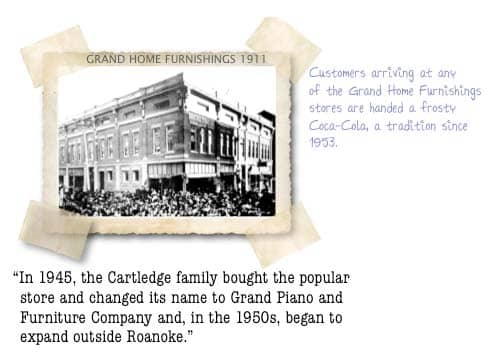
In 1945, the Cartledge family bought the popular store and changed its name to Grand Piano and Furniture Company and, in the 1950s, began to expand outside Roanoke to towns and cities dotted through the lush hills and valleys. They phased pianos out in 1998 and the store’s name was changed again, this time to Grand Home Furnishings.
Somehow, in 1953, a new tradition emerged down east at the Lynchburg store. Any customer arriving at any of the Grand stores is offered a frosty cold Coca-Cola as they walk through the door, Grand’s way of saying, “Thanks for visiting our store, and make yourself at home!” Today, Grand greets customers with over 1,250,000 Coca-Colas annually.
There are now 17 Grand Home Furnishings stores in 15 cities and towns throughout Western and Central Virginia, East Tennessee and the eastern part of West Virginia, one of the largest furniture chains in the South based on the amount of furniture sold. Grand employs over 600 people in their three-state operation.
And Grand returns to the communities in which it operates thousands of dollars each year in support of charitable organizations, and donations of furniture and services. The Company maintains a unique Benevolent Fund. Through voluntary payroll deductions, employees pay into a fund that’s matched, dollar for dollar, by the company. Employee representatives in each store administer the fund within their own community. The company also supports various non-profit groups through the Cartledge Foundation, a charitable trust set up by the family.
1911 -Loory’s
Our stories lead us back to the City of New York. The year is 1911, and Max Loory, a peddler on the lower east side, has made the decision to seek better business opportunities in New Jersey. Mel Loory, his grandson, tells the tale. “Max was also mindful of his doctor’s advice that the crowded New York tenements were unhealthy for his wife, Anna. He packed his family and belongings in a horse-drawn wagon and ventured into the gentle hills of Dover, New Jersey, where he began a garment store, later enlarged into Loory’s Department Store, one of the vital businesses on Dover’s legendary Blackwell Street.
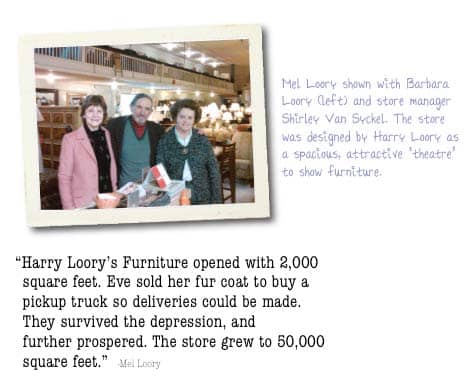
“From the beginning, all of Max and Anna’s children worked in the store and Harry, the eldest son, became its manager. When he and my mother, Eve, married in 1930, the great depression had begun and family finances were strained. The couple branched out with a store of their own in 1931. Naturally, they could not open up a business that would compete with Max’s, so they decided to try furniture and floor coverings.
“Harry Loory’s Furniture opened with 2,000 square feet. Eve sold her fur coat to buy a pickup truck so deliveries could be made. For a time, my folks lived in an apartment above the store. Because they were optimistic, talented hard-workers, and the Loory name had already become synonymous with fair business practices, the store did business from its very beginning. So much so, that in 1935 they put on an enormous addition.
“They survived the depression, and further prospered. The store grew to 50,000 square feet. Today our customers look around the main showroom (it’s 180 feet long and 16 feet high with a balcony around three sides and a lovely stamped tin ceiling) and they ask, ‘What did this place used to be, a ballroom, a theatre?’ The answer, of course, is that this is the way Harry Loory designed his store, a spacious attractive ‘theatre’ where people could find the furniture for their homes with the help of a pleasant, attentive staff.
“Our address, ‘One Towpath Square’, was chosen by my father in memory of the towpath of the old Morris Canal that ran behind the store. He swam in the canal as a boy and wanted to keep the memory of the canal and its history alive.
“I joined my parents’ business in 1969, just as small towns like ours were beginning to suffer from competition from the big box stores along the highways and from the growing popularity of malls. Businesses that had been in Dover for years, relocated to the mall or went out of business. Harry Loory’s was one of the few to stay in the community and run against the current.
“I increased the advertising budget and took on some new lines, but basically Harry Loory’s retained its identity. Though there have been challenges, the current recession being one of them, we have never regretted our decision to stay in Dover. My wife, Barbara, takes time from her writing to help me in the business and, together with our store manager, Shirley Van Syckle, we keep the ship headed into the wind.
“The secret to our success? We don’t claim to know any secrets or special tricks, and we don’t consider ourselves experts. But we have roots deep in the community, and we respect our customers and want them to feel at home. Because of our size, we’re in a position to display an extraordinary amount of furniture (probably the largest inventory in New Jersey) from over 60 different manufacturers. Famous national brands, small American ‘artisan’ shops, large importers, they are all represented on our floor. You can see pieces at Harry Loory’s that you’d have a hard time finding elsewhere. And we don’t go in for gimmicks. Our pricing is competitive and fair all year round, and our delivery is free and made by our own men in our own vehicles.
“People enjoy looking at the old photographs on our walls as they shop for the latest in furniture for every room in the house.
“Perhaps that is the ‘secret to our success’. People enter our store and they feel a sort of harmony between the past and the present and an optimism about the future.” to be continued...
These are some of your stories, but there are many more to come! We asked that you share your histories and insights with us, and you responded so generously that we had to pause, with the philosophy and reminiscence of Mel Loory.
The celebration of your longevity and ours will continue in Furniture World’s next issue, advancing toward our present times with the following retail histories completed so far...
•Mount Morris
•Critelli Furniture
•Robb and Stuckey
•Coulter’s
•El Dorado
•Ikea
•Tepperman’s
•La-Z-Boy
•Kittle’s
•R. C. Wiley
•McArthur’s
•Aaron’s
•Art Van
•Interiors by Joan
•Decorium
•Conway Furniture,
•Furnitureland South
•Stone Creek
•J. S. Furniture (Furniture & More)
•American Furniture
•Home Furniture
•Mattress Giant
•Gallery Furniture
•Bernie and Phyll’s
•Sleep Train
•Inside Out
...and others out there who were perhaps just not able to find that right vintage photo in time. Keep looking, it’s not too late. Just email editor@furninfo.com for details.
The industry and all of us at Furniture World will thank you!
CLICK HERE to see FURNITURE WORLD Magazine's entire 140th year anniversary issue in "Flip Page" format.
Janet Holt-Johnstone is an international marketer and editor, happily contributing to Furniture World Magazine for the past 20 years. She also writes/edits for CanWest publications, the Globe and Mail, The Toronto Star and many shelter magazines, and edited the award-winning Korean War epic, “One Bugle, No Drums”, by William B. Hopkins. Janet has just completed her first novel, “The Devil Knows”.